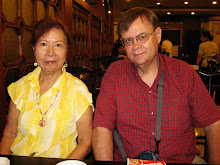This particular tea is produced in Sichuan province on Emei Mountain. Some tea connoisseurs claim that this tea is one of the finest green teas available. According to these connoisseurs, this prized tea is a true treat, with a unique and delicate appearance and flavor.
Quite frankly there is not much to be found as far as information goes on this particular type of green tea. It is very expensive, so I doubt if we buy a lot of it.
As I stated in an earlier blog, we bought our Que She with three other types of Emei Mountain greens. It has taken me this long to get around to finding out about it.
 As seen earlier in one of my blog reviews, this is the package the Que She came in. It weighed in at 50 grams and was not cheap.
As seen earlier in one of my blog reviews, this is the package the Que She came in. It weighed in at 50 grams and was not cheap. The leaves are about half the size of Zhu Ye Qing and thinner. They are delicate and multicolored with a deep pastel green being the predominant color. The leaves are solid and relatively heavy for a tea.
The leaves are about half the size of Zhu Ye Qing and thinner. They are delicate and multicolored with a deep pastel green being the predominant color. The leaves are solid and relatively heavy for a tea. Up close, one can get a good idea of the shapes and colors as well as the delicate hairs on each leaf.
Up close, one can get a good idea of the shapes and colors as well as the delicate hairs on each leaf. The leaves made a light pale amber liquid similar to all the other teas of this type, such as Zhu Ye Qing and Xue Ya. The taste is very pleasant although I could not smell any chestnuts or anything like this. I do not know if I could really tell the difference between the green teas mentioned above. The Zhu Ye Qing is certainly the stronger of the three with a much heavier taste and aftertaste. Que She is closer to Xue Ya in its mildness. It has a bitter-sweet aftertaste but it does not last very long. This is most definitely a very pleasant and wonderful tea. It, along with the Zhu Ye Qing and Xue Ya, are all very close in taste and aroma and feeling. All are great teas worth drinking and enjoying.
The leaves made a light pale amber liquid similar to all the other teas of this type, such as Zhu Ye Qing and Xue Ya. The taste is very pleasant although I could not smell any chestnuts or anything like this. I do not know if I could really tell the difference between the green teas mentioned above. The Zhu Ye Qing is certainly the stronger of the three with a much heavier taste and aftertaste. Que She is closer to Xue Ya in its mildness. It has a bitter-sweet aftertaste but it does not last very long. This is most definitely a very pleasant and wonderful tea. It, along with the Zhu Ye Qing and Xue Ya, are all very close in taste and aroma and feeling. All are great teas worth drinking and enjoying.


2 comments:
Hi,
thanks for the information about que she. I have received quite alot of quantity of this tea for myself from a friend. And being a novice tea drinker , I cannot conclude the right water temperature and brewing time for Que She from Si chuan.
Also, is it advisable to have this tea gong fu style?
Many thanks,
Indruj
This tea should be brewed with water 70-80 degrees, so not boiling. The first brew can be bitter, so it is recommended that you make a brew for 1 minute with the leaves submerged. Use this brew to warm your cup only. Refill the tea pot and wait a further 1-2 minutes before emptying the warm cup and pouring your first properly brewed, hopfully sweet cup of tea.
Post a Comment